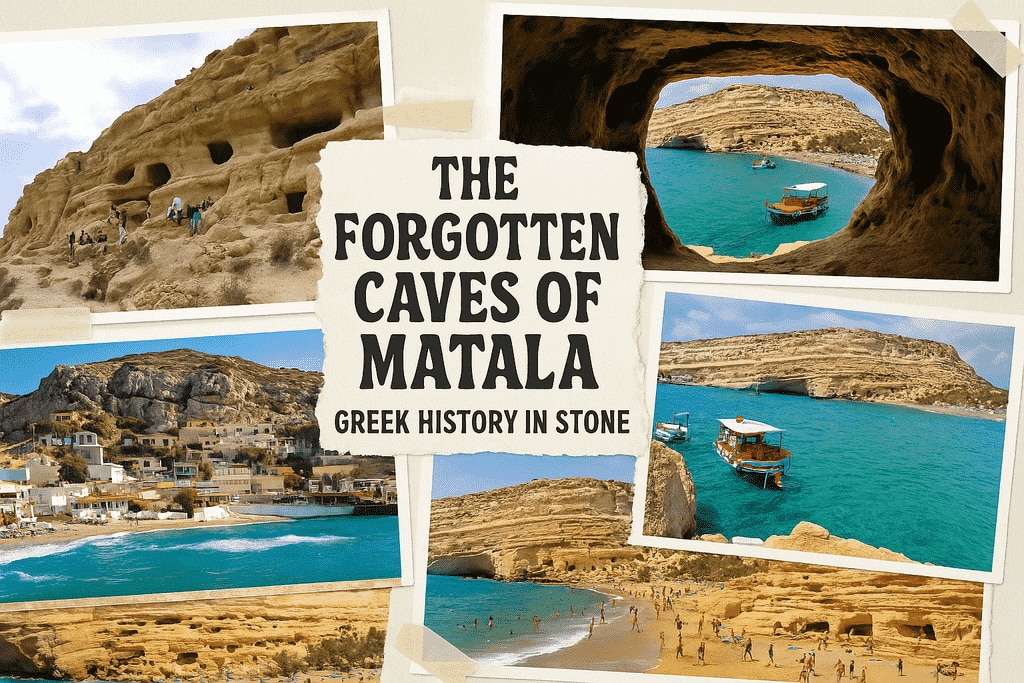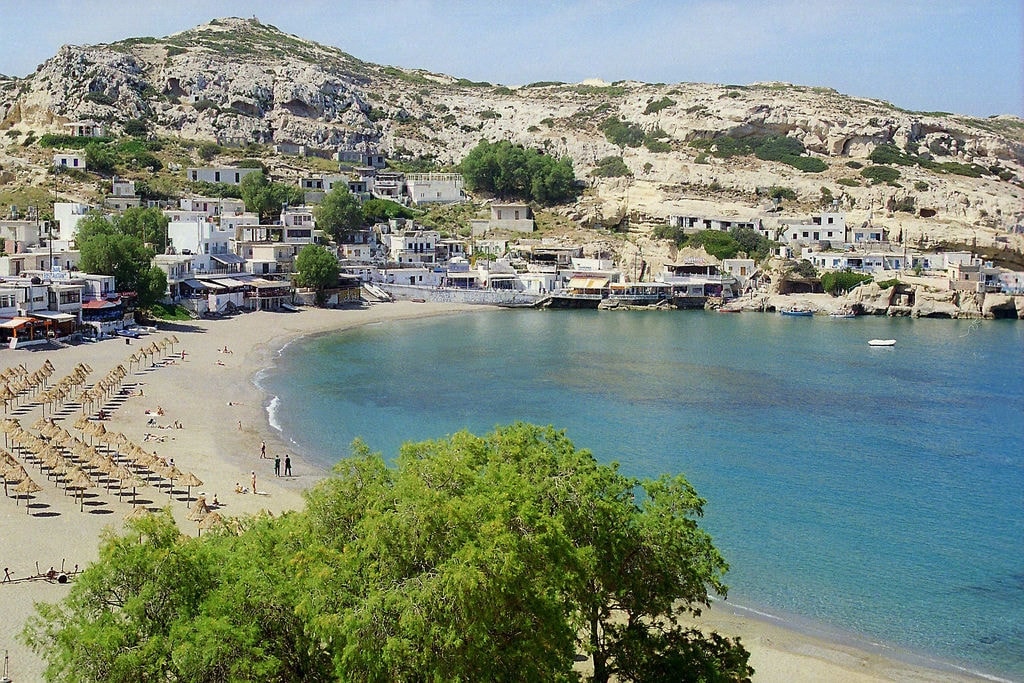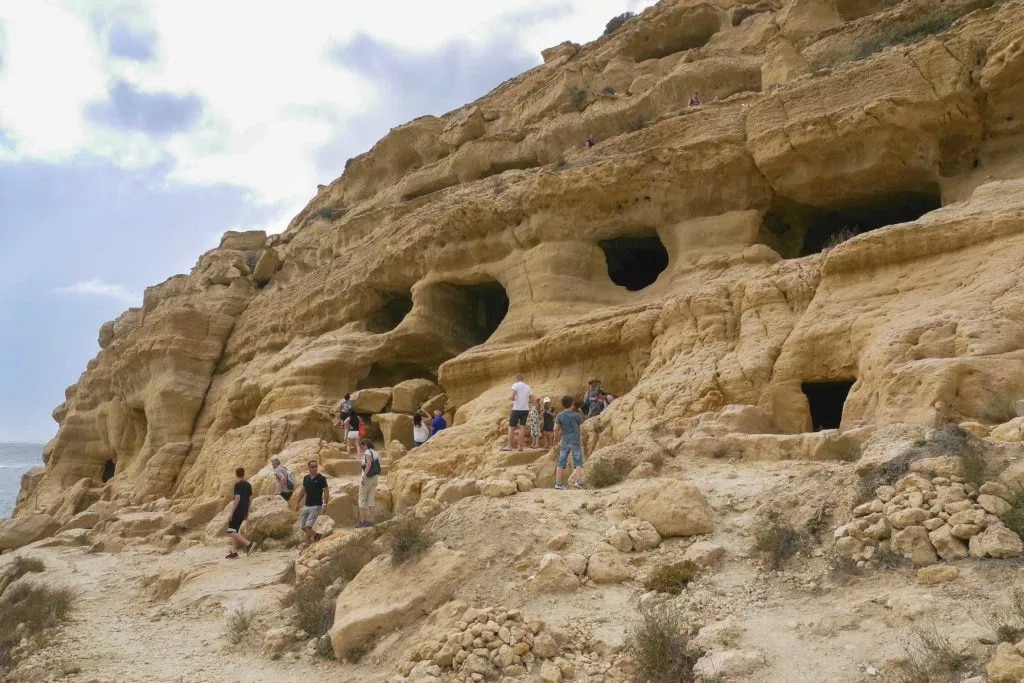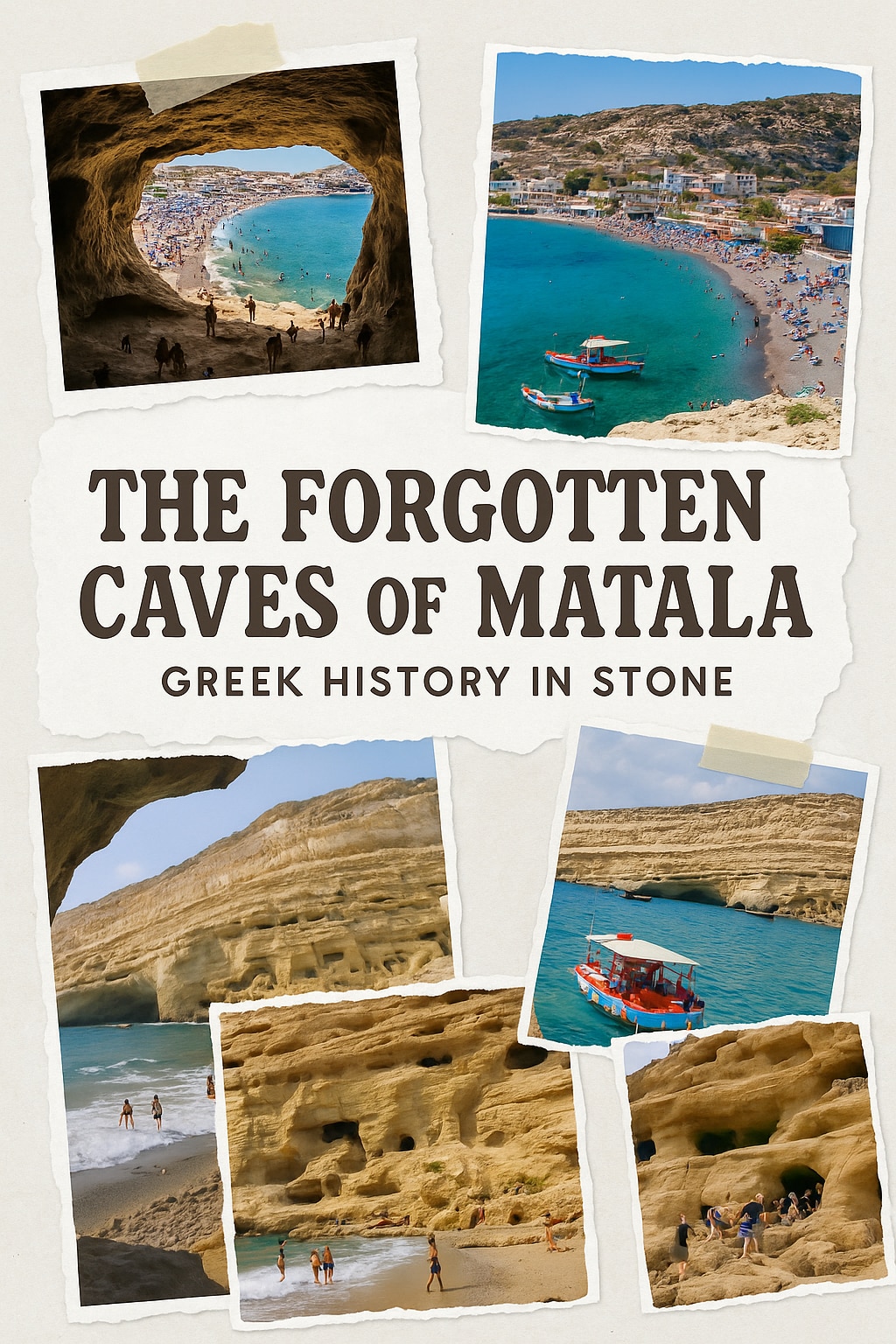The Forgotten Caves of Matala – Greek History in Stone
When most people think of Crete, they imagine whitewashed villages, the turquoise waters of Elafonissi, or the legendary palace of Knossos. But tucked away on the southern coast of the island is a place where history isn’t just told—it’s carved into the very walls of the earth. Matala, a small fishing village far from the busy tourist hubs, is home to a stunning, almost surreal cliffside of man-made caves. These are not just holes in the rock. They are silent chambers of time, once used as homes, graves, and hiding places. Forgotten by many and overshadowed by Crete’s more famous sights, the caves of Matala offer a haunting, atmospheric glimpse into the island’s layered past.
Arriving in Matala
The journey to Matala sets the tone for what lies ahead. The drive from Heraklion takes around 1.5 to 2 hours, winding through sleepy villages, olive groves, and the dry, rugged beauty of southern Crete. As you approach the coast, the mountains open up, revealing a wide bay and the shimmering expanse of the Libyan Sea. Matala is a simple place. It has a relaxed, almost bohemian atmosphere. There are no massive resorts here, just a few guesthouses, tavernas, and cafes where locals serve fresh fish with the calmness that only comes from generations of sea living. But the real draw of Matala isn’t the beach—though it’s beautiful—but the cliff that towers on its northern end, honeycombed with shadowy openings.
The Mysterious Origin of the Caves
Walk up to the cliff and you’ll immediately see dozens of man-sized holes in the sandstone face. At first glance, they look like natural formations—sea-weathered arches and crevices. But step inside, and everything changes. The caves are geometrically precise, with right-angled walls, carved benches, niches, and even steps. They weren’t shaped by water or wind. They were made by human hands. Archaeologists believe the caves date back to the Neolithic period, over 3,000 years ago. Over time, they were reused and repurposed by Romans, early Christians, hermits, and even smugglers. In some, you can still find engravings and makeshift altars, silent evidence of ancient rituals and quiet prayers.
Caves as Tombs
One of the most common uses of the Matala caves during Roman times was as tombs. The size and layout of many chambers—complete with carved niches for placing bodies—suggest they served as resting places for the dead. But not in a morbid way. The Romans believed in maintaining ties with the deceased, and Matala, with its soft rock and proximity to the sea, offered an ideal place for coastal burial. You can still feel a strange peace inside the caves, a kind of timeless stillness. Unlike the sterility of modern cemeteries, these tombs feel warm, intimate, human.
Early Christians and the Secret Church
During the early Byzantine period, Christians fleeing persecution or seeking solitude used the caves as places of worship. One of the largest caves is known locally as “The Church,” because it has a small carved apse and a rectangular layout that resembles a chapel. According to local stories, secret services were held here during times when Christianity was still a forbidden faith. It’s hard to confirm the full truth of these legends, but standing inside the cool, dim chamber, it’s easy to imagine candlelight flickering against the stone walls, chants echoing softly in the dark.
A Hippie Hideaway
The caves’ most recent moment of fame came in the 1960s and 70s, when Matala became an unlikely outpost for Western hippies seeking a spiritual retreat. Inspired by freedom, nature, and the hope of peace, they moved into the caves—many living there for months at a time. They painted, wrote music, danced, meditated. Some were escaping war drafts or rigid society, others just wanted to live simply. One of the most famous visitors was Joni Mitchell, who later immortalized Matala in her song “Carey.” Eventually, the Greek government forced the squatters out, but the legacy of that era remains. Some graffiti still lingers on the walls—reminders of those years when Matala became a countercultural sanctuary.
Visiting the Caves Today
Today, the caves are part of a protected archaeological site. There’s a small entrance fee—about 4 euros for adults—and visitors are allowed to explore them during daylight hours. The experience is both humbling and exhilarating. There are no flashy signs or artificial lighting. Just you, the rock, and the sound of waves crashing below. Some caves require a bit of climbing, so wear good shoes. The stone can be slippery, especially in the early morning when it’s still damp from sea mist. But even a short walk will lead you into chambers where ancient people once lived, mourned, worshipped, and dreamed.
What to Wear and Bring
Matala is hot and dry for most of the year. If you’re visiting in summer, wear lightweight clothing, a hat, and sunscreen. Bring water with you—there’s none sold inside the site. If you plan to climb higher along the cliff, wear closed shoes with grip. You’ll also want a flashlight or use your phone’s light to explore the darker chambers safely. Photography is allowed, but drones are prohibited without special permission. The best time to visit is early morning or late afternoon, when the sunlight slants across the cliff face and the beach is still quiet.
Eating and Staying in Matala
After exploring the caves, the best thing to do is relax in one of the seaside tavernas. Try grilled octopus, local olives, and dakos—a traditional Cretan dish with barley rusks, tomatoes, and cheese. Meals are affordable, usually between 10 to 15 euros per person. Most of the restaurants overlook the bay, offering a perfect view of the caves you just explored. If you decide to stay overnight, there are a handful of guesthouses and boutique hotels in Matala. Rooms range from 40 to 80 euros per night, depending on the season. Some places offer cave-style rooms inspired by the original dwellings, combining rustic charm with modern comfort.
Beyond the Caves: Other Attractions Nearby
While the caves are the star of the show, Matala’s surroundings are worth exploring too. A short hike over the hill leads to Red Beach, a secluded cove with crimson sand and crystal-clear water. It’s unofficially a nudist-friendly beach, but it’s welcoming to all. Another local spot is the ancient city of Phaistos, just 20 minutes away by car. Less crowded than Knossos, it offers incredible Minoan ruins and panoramic views over the Messara Plain. You can also visit the nearby village of Kamilari, known for its relaxed vibe and friendly locals, or take a drive to the mountain village of Zaros, famous for its spring water and peaceful hiking trails.
The Soul of Matala
What makes Matala’s caves so unique is not just their age or the people who used them, but the way they make you feel. This isn’t a flashy tourist attraction with crowds and souvenirs. It’s a place of echoes. Every step into a cave feels like a step backward in time. You’re reminded that history isn’t just in books or museums—it’s in the soil, in the stone, in the places where real people lived real lives. Whether you’re a history lover, a seeker of hidden places, or just someone who loves quiet beauty, Matala offers something rare. It’s a piece of Greek history that doesn’t demand your attention—it waits patiently for those curious enough to find it.
Practical Tips for Your Visit
Getting There: From Heraklion, rent a car for the most flexibility. Buses are available but infrequent. The road to Matala is well-maintained, with good signage. Parking is free or low-cost near the beach.
Best Time to Visit: May to October is ideal. Avoid midday in July and August due to extreme heat. Early morning visits are cooler and less crowded.
Entrance Fee: 4 euros for adults, 2 euros for children or students. Children under 10 can enter for free. Tickets are bought at a small booth near the cave entrance.
Opening Hours: Typically from 8:00 to 20:00 during summer, with shorter hours in spring or fall.
Local Contacts: There are local guides who offer private tours of the caves and the village. Costs range from 20 to 40 euros depending on the group size and duration. No guide is required for entry, but a guided tour adds a lot of historical insight.
Internet and Phone: Mobile coverage is generally good in Matala, though signal may drop slightly inside the caves.
Final Thoughts
The caves of Matala are more than just an archaeological site. They’re a journey into another world—a place where you can connect with the deep rhythms of history and the sea. They offer a raw, authentic experience that stands in contrast to Crete’s polished tourist spots. Here, the wind whispers through carved openings, footsteps echo in ancient chambers, and the sea crashes below as it has for millennia. If you’re looking for a place where history feels alive and unfiltered, put Matala on your map. Just don’t be surprised if a part of you decides to stay.










